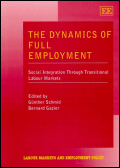SELECTED FOR YOU... MARCH 2010: books of the month - working papers
All the Selected for you
BOOKS
Health in the European Union : trends and analysis.
La santé dans l'Union européenne : tendances et analyses.
Mladovsky P., Allin S., Masseria C., Hernandez-Quevedo C., McDaid D., Miossalos E.
Copenhague : OMS Bureau régional de l'Europe : 2010 : 164 p.
This book discusses and analyses the relationship between living conditions, socioeconomic factors and health with the objective of framing a debate and policy action to create a healthier and fairer society across Europe. This study will serve to stimulate focused discussion by offering an essential overview of key issues affecting European nations and the health and well-being of their peoples (4e de couverture).
Nordic health systems. Recent reforms and current policy challenges.
Les systèmes de santé nordiques. Les réformes récentes et les défis politiques en cours.
Magnussen J./éd., Vrangbaek K./éd., Saltman R.B./éd.
Maidenhead : Open University Press : 2009 : 339 p.
This book examines recent patterns of health reform in Nordic health systems, and the balance between stability and change in how these systems have developped. The following themes are explored : politicians, patients and professions; financing, production and distribution; the role of primary health sector; the role of public health; internal management mecanisms; impact of the European region (4e de couverture).
Who has the cure ? Hamilton project ideas on Health Care.
Qui a le remède ? Le projet Hamilton d'idées sur les soins de santé.
Furman J.
New York : Brookings Institution : : 278 p.
Since its launch in 2006, the Hamilton Project at Brookings has produced extensive original research on how to create a growing economy that benefits all Americans—to produce a prosperity that is both broad and deep. Its work on health care reflects its overall goal of achieving broad-based economic growth while improving economic security. Who Has the Cure? is a synthesis of the Hamilton Project's best thinking on the topic and an important and original contribution to that end.Former White House adviser Jason Furman and his colleagues emphasize the importance of universal health care, to individuals and to the overall economy. The authors look at four alternatives for achieving universal health care coverage that also improve efficiency in the health care industry. Who Has the Cure? also provides a series of papers on proposals for improving the effectiveness and affordability of health care, including a framework for income-related cost-sharing, a proposal to expand preventive care, and a reform to the Medicare prescription drug benefit (4e de couverture).
The dynamics of full employment : social integration through transitional labour markets.
La dynamique du plein emploi : intégration sociale par les marchés du travail en transition.
Schmid G., Gazier B.
Cheltenham : Edward Elgar : 2002 : 18-443 p.
Persistent unemployment is recognised as one of the main mechanisms of social and political exclusion. The Dynamics of Full Employment provides a new and fresh approach to the question of full employment in contemporary society. It offers an internationally comparative, interdisciplinary approach to the dynamics of full employment and views the labour market not only as an economic institution, but as a social one. The authors argue that transitional markets – defined as legitimate, negotiated and politically supported sets of mobility options – are becoming essential ingredients of successful employment policies in modern societies. Social integration through participation in the labour market should not exclude productive activity in other spheres of life (4e de couverture).
WORKING PAPERS
Health Insurance
The Tax Exclusion for Employer-Sponsored Health Insurance. 

Exonération de taxes pour les employeurs proposant à leurs employés une assurance santé.
Gruber J.
Cambridge : NBER : 2010/02 : 32 p.
This paper reviews the issues around and impacts of the tax exclusion for employer-sponsored insurance. After reviewing the arguments for and against this policy, I present micro-simulation evidence on the federal revenue, insurance coverage, and distributional impacts of various reforms to the exclusion.
Health Expenditures
Health Care Expenditure and Income in the OECD Reconsidered: Evidence from Panel Data. 

Les dépenses de santé et le revenu dans les pays de l'OCDE réexaminées : résultats de données de panel.
Baltagi J., Moscone F.
Syracuse : Maxwell school of Syracuse University : 2010/01 : 22 p.
This paper reconsiders the long-run economic relationship between health care expenditure and income using a panel of 20 OECD countries observed over the period 1971-2004. In particular, the paper studies the non-stationarity and cointegration properties between health care spending and income. This is done in a panel data context controlling for both cross-section dependence and unobserved heterogeneity. Cross-section dependence is modelled through a common factor model and through spatial dependence. Heterogeneity is handled through fixed effects in a panel homogeneous model and through a panel heterogeneous model. Our findings suggest that health care is a necessity rather than a luxury, with an elasticity much smaller than that estimated in previous studies.
Health Status
Years of Schooling, Human Capital and the Body Mass Index of European Females. 

Niveau d'éducation, capital humain et indice de poids corporel des Européennes.
Brunello G., Fabbri D., Fort M.
Bonn : The Institute for the Study of Labor : 2009/12 : 29 p
We use the compulsory school reforms implemented in European countries after the II World War to investigate the causal effect of education on the Body Mass Index (BMI) and the incidence of overweight and obesity among European females. Our IV estimates suggest that years of schooling have a protective effect on BMI. The size of the estimated effect is not negligible but smaller than the one found in comparable recent work for the US. We depart from the current empirical literature in three main directions. First, we use a multi-country approach. Second, we complement the standard analysis of the causal impact of years of schooling on BMI with one relying on a broader measure of education, i.e. individual standardized cognitive tests, and show that the current focus in the literature on years of schooling as the measure of education is not misplaced. Last, we evaluate whether the current focus on conditional mean effects should be integrated with an approach which allows for heterogeneous responses to changes in compulsory education. Although our evidence based on quantile regressions is mixed, there is some indication that the protective effect of schooling does not increase monotonically from the lower to the upper quantile of the distribution of BMI. Rather, the marginal effect is stronger among overweight (but not obese) females than among females with BMI above 30.
The Effects of Relative Food Prices on Obesity — Evidence from China: 1991-2006. 

Les effets des prix relatifs de la nourriture sur l'obésité - résultats en Chine : 1991-2006.
Lu Y., Goldman D.
Cambridge : NBER : 2010/01 : 36 p.
This paper explores the effects of relative food prices on body weight and body fat over time in China. We study a cohort of 15,000 adults from over 200 communities in China, using the longitudinal China Health and Nutrition Survey (1991-2006). We find that the price of energy-dense foods has consistent and negative effects on body fat, while such price effects do not always reflect in body weight. These findings suggest that changes in food consumption patterns induced by varying food prices can increase percentage body fat to risky levels even without substantial weight gain. In addition, food prices and subsidies could be used to encourage healthier food consumption patterns and to curb obesity.
Hospital
Hospital Competition and Quality with Regulated Prices. 

Concurrence hospitalière et qualité avec des prix régulés.
Kurt R. Brekke K.R., Sicilian L., Straume O.
New York : Social Science Research Network : 2009/04 : 22 p.
We analyse the effect of competition on quality in hospital markets with regulated prices, considering both the effect of (i) introducing competition (monopoly versus competition) and (ii) increasing competition through lower transportation costs (increased substitutability) or a higher number of hospitals. With semi-altruistic providers and a fairly general cost structure, we show that the relationship between competition and quality is generally ambiguous. In contrast to the received theoretical literature, this is consistent with, and potentially explains, the mixed empirical evidence.
The Impact of Competition on Management Practices in Public Hospitals. 

L'impact de la concurrence sur les pratiques managériales dans les hôpitaux publics.
Bloom N., Propper C., Seiler S., Van Reenen J.
Stanford : Stanford University : 2009/10 : 35 p.
We exploit a unique dataset and natural experiment to identify the impact of competition on public hospital management practices. We use a new double-blind management scoring tool to interview 161 physicians and managers in English National Health Service (NHS) hospitals, covering 61% of acute hospitals. We find this management measure is strongly correlated with hospital performance as measured by clinical outcomes (e.g. survival rates from heart attacks) and general operational and financial outcomes. We then instrument the number of competing local public hospitals with the share of marginal local political constituencies. In the UK the Government almost never closes public hospitals in political marginals because they risk losing seats in a general election. But they do regularly close hospitals in both their own and the oppositions non-marginal constituencies. Over the period we study the Labor government closed a large number of hospitals, leading to wide variations in hospital concentration levels, which are strongly correlated with whether the constituency was politically marginal. Exploiting this identification we find that product market competition, as proxied by the proximity of other hospitals, is significantly associated with better management.
Health inequalities
Reducing the Risks to Health: The Role of Social Protection Report of the Social Protection Task Group for the Strategic Review of Health Inequalities in England Post 2010. 

Réduire les risques liés à la santé : le rôle du rapport du groupe de travail sur la protection sociale dans la revue stratégique des inégalités de santé en Angleterre après 2010.
Glennerster H.
Londres : LSE : 2009/06 : 46 p.
We demonstrate that the introduction of social protection systems as well as their generosity and coverage have significant impacts on health. Who receives the benefits within the household affects the health outcomes for the family. The eligibility for and administration of benefits matters. We examine the growth of means testing in the UK and its recent modifications. We find serious difficulties facing those with long term medical conditions who are on the margins of the labour force. Collaboration between the health and social protection systems is poor. We give particular attention to gender and health and the implications this has for the social protection system. We also consider the fate of groups like asylum seekers who are excluded from its normal working.
Drugs
Generic Utilization Rates, Real Pharmaceutical Prices, and Research and Development Expenditures. 

Taux d'utilisation des génériques, prix réels des médicaments et dépenses en recherche et développement.
Cook J.P., Hunter G., Vernon J.A.
Cambridge : NBER : 2010/02 : 23 p.
Generic utilization rates have risen substantially since the enactment of The Drug Price Competition and Patent Term Restoration Act (Hatch-Waxman) in 1984. In the year Hatch-Waxman was enacted, generic utilization rates were 19 percent; in contrast, today, the generic utilization rate is approximately 70 percent. Striking a balance between access to existing medicines and access to yet-to-be-discovered (and developed) drugs, through research incentives, was the principal objective of this landmark legislation. However, given the current rate of generic utilization, it seems plausible, if not likely, that any balance achieved by the 1984 Act has since shifted away from research incentives and towards improved access, ceteris paribus. Among other factors, recent mandatory substitution laws in most states have driven up generic utilization rates. In the current paper, we employ semi-annual data from 1992 to 2008 to examine the link between generic utilization rates and real U.S. prescription drug prices. This link is important because previous research has identified a causal relationship between real drug prices in the U.S. and industry-level R&D investment intensity. We identify a statistically significant, positive relationship between generic utilization rates in the U.S. and real U.S. prescription drug prices. Specifically, we estimate an elasticity of real drug prices to generic utilization rates of -0.15. This finding, when coupled with previous empirical work on the determinants of pharmaceutical R&D intensity, suggests an elasticity of R&D to generic utilization rates of about 0.090. While the magnitude of this elasticity is modest, as theory would predict—the effect of greater generic erosion of brand sales at patent expiration is heavily discounted due to the long time horizon to generic erosion when an R&D project is in clinical development. However, because there has been a very substantial increase in generic utilization rates since 1984, the impact on R&D is nevertheless quite large. We explore this and other issues in the current paper.
Organizational Reputations and the Observability of Public Warnings in 10 Pharmaceutical Markets. 

Réputations des organisations et observabilité des alertes sanitaires publiques dans dix marchés pharmaceutiques.
Maor M.
New York : Social Science Research Network : 2009/03 : 47 p.
I present a verbal model in the policy domain of drug safety which suggests that media coverage of the regulator's catastrophic errors is a function of the regulator's predominant basis of reputation. Media coverage will be lowest when the regulator has a reputation for scientific expertise in pre-approval drug evaluation (or when it “shadows” decisions by regulators with this reputation for expertise), and highest when it has a reputation as a guarantor of public safety in the media. Empirical tests of the model were conducted in the form of an analysis of public warning procedures following safety-based drug withdrawals in the U.S., U.K., Germany, Canada, South Africa, Australia, New Zealand, Ireland, Israel, and Switzerland between 1975 and 2004. This, in conjunction with a descriptive statistical analysis of the media coverage of these warnings, supports the model's prediction. The findings presented here undermine Carpenter's (2002; 2004) assumption that regulators cannot recover reputation losses resulting from the approval of a truly dangerous drug. They also imply that patients living in countries with guardian regulators (e.g., Australia, New Zealand and Ireland), as well as patients who are attuned to the media arena in these countries, will be more aware of safety-based drug withdrawals than patients living in countries with expert regulators (e.g., U.S., Germany, the U.K.) or regulators that mimic the decisions of expert regulators (e.g., Canada, Switzerland, Israel and South Africa). Finally, the type of reputation an organization has plays a key role in determining its behavior. Therefore, social scientists should redirect their focus from determining the existence of an organization's reputation to gauging the precise nature of the reputation an organization has.
Primary health care
Incentive Compatible Reimbursement Schemes for Physicians. 

Incitations compatibles avec les schémas de remboursement pour les médecins.
Emons W.
New York : Social Science Research Network : 2010/01 : 17 p.
We consider physicians with fixed capacity levels. If a physician's capacity exceeds demand, she may have an incentive to overtreat, i.e., she may provide unnecessary treatments to use up idle capacity. By contrast, with excess demand she may undertreat, i.e., she may not provide necessary treatments since other activities are financially more attractive. We first show that simple fee-for-service reimbursement schemes do not provide proper incentives. If insurers use, however, fee-for-service schemes with quantity restrictions, they solve the fraudulent physician problem.
Health care systems
Improving China's health care system. 

Améliorer le système de santé chinois.
Herd R., Hu Y.W., Koen V.
Paris : OCDE : 2010/02 : 30 p.
Dans l'ensemble, les résultats de la Chine en matière de santé se sont considérablement améliorés au cours des trente dernières années, surtout par suite du recul de certaines maladies infectieuses classiques. Toutefois, les taux de mortalité par maladies chroniques sont en progression, en particulier à cause de l'évolution des modes de vie et de la détérioration de l'environnement. L'offre de soins de santé est essentiellement publique et les hôpitaux absorbent une part grandissante des ressources. Le nombre de médecins a vite augmenté, mais leur niveau de formation est souvent peu élevé. La demande de soins s'est rapidement accrue, parallèlement aux revenus, et leur prix relatif s'est envolé jusqu'au début des années 2000. Les budgets des hôpitaux et la rémunération de leurs médecins dépendent en partie des produits pharmaceutiques qu'ils prescrivent et vendent, dont les prix sont réglementés et donnent lieu à un important financement croisé. Face à ces problèmes, les pouvoirs publics ont lancé des réformes. De nouveaux dispositifs d'assurance ont été mis en place dans les zones rurales et urbaines. Par conséquent, la population couverte et l'utilisation des équipements médicaux se sont beaucoup accrues, sauf dans le cas des migrants. Toutefois, dans les faits, les maladies catastrophiques, mais aussi les affections chroniques, continuent de faire tomber dans la pauvreté ceux qu'elles touchent, surtout dans les régions déshéritées, la mutualisation des risques à l'échelle nationale demeurant limitée. En 2009 a été annoncée la mise en oeuvre d'une nouvelle série de réformes dont le but est d'assurer un accès universel à des soins de santé de base à la fois sûrs, d'un coût abordable et efficaces d'ici à 2020. Ces mesures prévoient des investissements dans les infrastructures médicales, la généralisation de la couverture maladie, une intensification des efforts de prévention, l'instauration d'un nouveau dispositif pour les médicaments essentiels et des restructurations d'envergure, dont une réforme des hôpitaux. Il importera de faire en sorte que le rôle des soins primaires soit renforcé et que les hôpitaux soient gérés de façon plus rationnelle dans le cadre d'un système moins hiérarchisé. Il faudra en outre modifier les prix relatifs des traitements et augmenter la rémunération des médecins, ainsi que le prix du tabac.
Spatial competition between health care providers: effects of standardization. 

La concurrence spatiale entre les producteurs de soins : les effets de la standardisation.
Kuchinke B.A., Zerth J., Wiese N.
Ilmenau : Ilmenau University of Technology. Institute of Economics : 2009 : 22 p.
In the international health care literature there is a broad discussion on impacts of competition in health care markets. But aspects of standardization in regional health care markets with no price competition received comparatively little attention. We use a typical Hotelling-framework (reference case) to analyze a regional health care market with two health care providers competing in (vertical) quality after the scope of medical treatment is set (horizontal quality). We conclude, that in the reference case both health care provider will use vertical quality to separate from each other. In the next step (standardization case) we introduce one health care provider to be the standard leader in vertical quality. In the standardization case a more homogeneous supply can be expected. But, there is a higher possibility that the standard follower has to leave the regional health care market.
Competition Between HMO and PPO: A Two-Sided Market Approach. 

Concurrence entre HMO et PPO : une approche duale du marché
Bardey D., Rochet J.C.
New York : Social Science Research Network : 2009/12 : 17 p.
Classical analysis of health insurance markets often focuses on adverse selection, which creates a direct externality between the enrollees of the same health plan: under an imperfect risk adjustment, the higher the risks of my co-enrollees, the higher my cost of insurance. This has lead to the view that restricting the diversity of accessible physicians may be good for policyholders, in a context where competition between health plans can lead to a "death spiral" for the less restrictive plan. This paper defends the opposite view that diversity might pay, because of the indirect externality between policyholders and physicians. By attracting higher risks, the less restrictive plan may also guarantee a higher level of activity to its physicians, and therefore negotiate with them a lower fee-for-service rate. By explicitly modeling the two sides of the market for health (policyholders and physicians), we are able to find examples in which competition between health plans gives a higher profit to the less restrictive plan.
Health and Work
Do People Become Healthier after Being Promoted? 

Les personnes sont en meilleure santé après avoir été promues ?
Boyce C.J., Oswald A.J.
Bonn : The Institute for the Study of Labor : 2008/12 : 37 p.
This paper uses longitudinal data to explore whether greater job status makes a person healthier. Taking the evidence as a whole, promotees do not exhibit a health improvement after promotion. Instead the data suggest that workers with good health are more likely to be promoted. In the private sector, we find that job promotion significantly worsens people's psychological strain (on a GHQ score). For the public sector, there are some tentative signs of the reverse. We discuss caveats to our conclusions, suggest caution in their interpretation, and argue that further longitudinal studies are needed.
Mental Health and Working Conditions in European Countries. 

Santé mentale et conditions de travail dans les pays européens.
Cottini E. Lucifora C.
Bonn : The Institute for the Study of Labor : 2010/01 : 36 p.
Increased pressure for labour market flexibility and increasing demand over workers' performance have fostered the idea that working conditions, in most European countries, have progressively deteriorated with adverse effects on psychological well being and mental health. This paper investigates the links between contractual arrangements, working conditions and mental health using time-series cross-section data for 15 European countries. We use different waves of the European Working Conditions Survey (1995, 2000, 2005) to document recent patterns in mental health at the workplace and to assess how these are related to various job attributes. We find substantial heterogeneity in mental health incidence at the workplace both across workers, as well as between countries. Given population heterogeneity in responses to mental health questions, we implement a methodology for differential reporting in ordered response models which allows for threshold shifts. We show that a set of workplace attributes, such as: working in shifts, performing complex and intensive tasks and having restricted job autonomy lead to a higher probability of reporting mental health problems. We also provide evidence of a positive causal effect of adverse overall working conditions on mental health distress. We show that labour market institutions, and health and safety regulations can explain a significant part of cross-country differences.
Health and Ageing
Old Europe ages: Reforms and Reform Backlashes. 

La vieille Europe vieillit : les réformes et les réactions qu'elles suscitent.
Boersch-Supan A.H., Ludwig A.
Cambridge : NBER : 2010/02 : 46 p.
The extent of the demographic changes in Europe is dramatic and will deeply affect future labor, financial and goods markets. The expected strain on public budgets and especially social security has already received prominent attention, but aging poses many other economic challenges that threaten growth and living standards if they remain unaddressed. This paper focuses on three large Continental European countries: France, Germany, and Italy. These countries have large pay-as-you-go pension systems and vulnerable labor markets. At the same time, they show remarkable resistance against pension and labor market reform. While there is no shortage of reform proposals to address population aging, most of those focused on pension and labor market reform, little is known about behavioral reactions to such reforms.This paper therefore sheds light on the potential benefits of pension and labor market reform for growth and living standards, taking into account behavioral reactions to specific reforms. Which behavioral reactions will strengthen, which will weaken reform policies? Can Old Europe maintain its standard of living even if behavioral reactions offset some of the current reform efforts?



